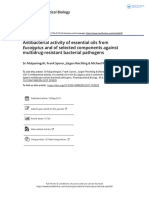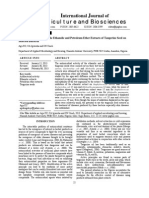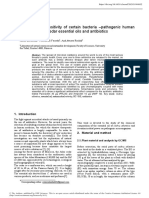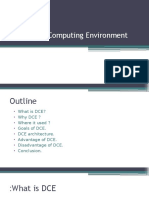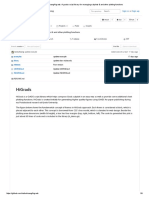E.O Ganoderma
E.O Ganoderma
Uploaded by
Raj KCCopyright:
Available Formats
E.O Ganoderma
E.O Ganoderma
Uploaded by
Raj KCOriginal Title
Copyright
Available Formats
Share this document
Did you find this document useful?
Is this content inappropriate?
Copyright:
Available Formats
E.O Ganoderma
E.O Ganoderma
Uploaded by
Raj KCCopyright:
Available Formats
168
Journal of Nanjing Medical University200923(3):168-172 Research Paper
JNMU
www.elsevier.com/locate/jnmu
Chemical composition and antimicrobial activity of essential oil isolated from the cultured mycelia of Ganoderma japonicum
a
The Key Laboratory of Industrial Microbiology of Hubei Province, Hubei University of Technology, Wuhan 430068, China;
b
Dandan Liua, Zheng Hua,*, Zhigang Liu a, Bo Yanga , Wenjuan Tub, Liang Lia
Received 25 January 2009
School of Biochemistry and Molecular Biology of Australian National University, Canberra, Australia 0200
Abstract
Objective:To explore a new natural antibiotic. Methods:The chemical composition of the essential oil from Ganoderma japonicum (G. japonicum) mycelia was analyzed by gas chromatography-mass spectrometry(GC-MS). The antimicrobial activity of the oil was evaluated against eighteen microorganisms, including bacteria, mildew and yeast by using a disc diffusion method. Furthermore, the minimum inhibitory concentrations(MIC) and the minimum bactericidal concentrations(MBC) of the essential oil against twelve clinical pathogens were determined. Results:The main components of the oil were nerolidol, decadienal, linalool and benzyl alcohol. The antimicrobial results indicated that the oil inhibited all the tested bacterium, especially Methicillin-resistant Staphylococcus aureus (MRSA) in which the antibacterial activity exhibited a MBC of 1.03 mg/ml. Conclusion: The essential oil of G. japonicum mycelium has significant inhibitory activity. It is a potential medicinal resource that can be used as a natural antibiotic.
Keywords: Ganoderma japonicum; essential oil; antimicrobial activity; clinical pathogens
Ganoderma japonicum is a species of fungus found in China, belonging to the family of Ganoderma P.Kars that has been used by traditional Chinese medicine for the treatment of various diseases. Previously traditional Chinese medical research has proved that G. japonicum can play many significant pharmacological roles, such as modulating the immune system, having anti-tumor[1-3] and anti-aging [4,5] effects, reducing blood sugar [6]; improving cardiovascular function[7], and providing an effective therapy for respiratory diseases. Modern Chinese medicinal research has also proved that G. japonicum mycelium has effects that are similar to wild G. japonicum for the clinical treatment of respiratory diseases[8]. In order to explore the G. japonicum mycelium pharmacology, we analyzed the components of G.
This work was supported by the Natural Science Foundation of Hubei Province(2004ABA228). * Corresponding author. E- mail address: huzheng@mail.hbut.edu.cn
INTRODUCTION
japonicum mycelium essential oil by GC-MS, and assayed its antibacterial activity by a disc agar diffusion assay and broth dilution method. The results showed that the essential oil of G. japonicum has multipharmacological effects and it also contains several bactericidal components, including(E)-nerolidol, linalool, and(2E,4E)-decadienal. The antibacterial experiments indicated that the oil has remarkable antibiotic activities against all the test microorganisms, especially the clinical pathogens. Our work provides a reliable experimental basis for the use of G. japonicum as a Chinese medicine in the treatment of respiratory diseases. Since antibiotics have become so widely used clinically, many microorganisms have developed antibiotic resistance, especially some clinical pathogens. Therefore, the search for new antibacterial drugs has become an important topic. Recently, some studies have shown that essential oils from certain plants and fungal mycelia have antibacterial activity, inhibiting the growth of drug-resistance bacteria [9 ,10 ]. For this reason, pharmacological research on the oils of medicinal fungi
D.Liu et al. / Journal of Nanjing Medical University, 2009, 23(3): 168-172
is important for the development of new potential antibiotics.
169
MATERIALS AND METHOD
Material and essential oil distillation The strain of fungus used was obtained from China General Microbiological Culture Collection Center (CGMCC):G. japonicum CGMCC As5.69. The G. japonicum mycelia were collected, and then subjected to hydro-distillation in a Clevenger-type apparatus for 3 hours. The essential oil was dried by anhydrous sodium sulphate. We carried out a parallel experiment on sterilized mycelia but did not inoculate blank media as a control. The oil was stored at -10 in the dark prior to chemical analysis and microbiological testing. GC-MS analysis and identification of compounds The G. japonicum mycelia essential oil and the negative control were analyzed by GC-MS. The analyses were carried out by using three different fused silica capillary columns(30 m 0.25 mm i.d.; film thickness 0.25m) of different polarities(DB-1, DB-5 and HP-Innowax). The oven temperature was programmed from 50 to 250 at a 3/min rate and held at this temperature for 10 min. Injector and interface temperatures were 220 and 250. Carrier gas was helium at 1.0 ml/min. Diluted samples(1.0 l, 1/10 in ether) were injected manually and the split ratio was adjusted to 40:1. GC-MS analyses were performed with a Thermo Finnigan TRACE GC and coupled with a TRACE MS plus(EI 70 Ev). The components were identified by comparison of the mass spectra with those of NIST 2.0 library data of the GC-MS system and Adams libraries spectra. The results were further confirmed by comparison of the compounds elution orders with the retention indices semi-polar phases reported in the literature [9]. Retention indices of the components were determined relative to the retention times of a series of n-alkanes with linear interpolation. The relative amounts of individual components of the essential oil were expressed as percentages of the peak area relative to the total peak area. Microbial strains Eighteen organisms were selected for this study, including 12 bacteria, 3 yeasts and 3 mildews. Some strains were obtained from The China Center for Type Culture Collection(CCTCC). They were Bacillus subtilis (CCTCC AB92068), Escherichia coli (CCTCC AB90054), Proteus vulgaris (CCTCC AB91103), Salmonella typhi(CCTCC AB94010), and Staphylococcus aureus (CCTCC AB203010). Three yeast spe cies were Candida sp. (CCTCC AY91001), Hansenula anomala AY92046, Saccharomyces cerevisiae
(CCTCC AY92042), and the three mildew species were Aspergillus niger(CCTCC AF91004), Mucor mucedo (CCTCC AF93229), Penicillium citrinum(CCTCC AF93094). In addition, we used seven bacteria which were isolated clinically: Klebsiella pneumoniae, Citrobacter freundill, Enterobacter cloacae, Staphylococcus saprophyticus, Enterococcus faecalis, Methicillin-sensitive Staphylococcus aureus and Methicillin-resistant Staphylococcus aureus(MRSA). Screening of antimicrobial activity The agar disc diffusion assay was employed for the determination of antimicrobial activity of the essential oil[11]. Briefly, a suspension of the test organism(2 108 CFU/ml) was spread on the solid media plates. Filter paper discs(6 mm in diameter) were individually impregnated with 15 of the diluted oil aliquots(200 l mg/ml stock), then placed on the inoculated plates, for 2 h at 4. The plates were incubated at 37 for 24 h for bacteria, and at 30 for 48 h for yeast, using a spread restraint method for epiphytes at 30 for 48 h[12]. The diameters of the inhibition zones(DD) were measured in millimeters. Each test was carried out in triplicate, repeated three times, and the average was calculated for the inhibition zone diameters. A positive c ontrol wa s pe rforme d using the a ntibiotic , Levofloxacin(5 g/disc). Deter m ination of m inimum inhi bitor y concentration(MIC) A broth microdilution method was used to determine the MIC and MBC[9,13] . All tests were performed in Mueller Hinton broth and Sabouraud Dextrose broth, both supplemented with ethanol at a final concentration of 0.5%(v/v) for both bacteria and yeasts, respectively. Serial doubling dilutions of the oils were prepared in a 96-well plate, ranging from 0.05 to 200.00 mg/ml. The final concentration of each strain was adjusted to 5 104 CFU/ml. Plates were incubated at 37 for 24 h for bacteria. The MIC was defined as the lowest concentration of the essential oil at which the microorganism does not demonstrate visible growth. The microorganism growth was indicated by the turbidity. Determination of minimum bactericidal concentration (MBC) To determine MBC, broth was taken from each well and incubated in Mueller Hinton Agar at 37 for 24 h for bacteria. Levofloxacin served as a positive control in parallel experiments. The MBC was defined as the lowest concentration of the essential oil at which the incubated microorganism was completely killed[9,13]. Each test was carried out in triplicates and repeated three times. Modal values were selected.
170
D.Liu et al. / Journal of Nanjing Medical University, 2009, 23(3): 168-172
mycelia was 0.18%(w/w) based on the dry weight of the sample. Forty-three components were detected by GC-MS, and 16 of them were identified(Fig. 1).
NL: 1.29E8 TIC F:MS zizhi
RESULTS
Chemical composition of the essential oil The yield of the essential oil from G. japonicum
RT:0.00-69.68 SM:7G 100 Relative Abundance 80 60 40 20 0 0 14.79 11.86 10 24.71 19.36 20 28.24 30 4.53
34.82
39.92 43.65 49.17 54.39 40 Time(min) 50 62.00 60
Fig. 1
GC-MS total ion count chromatograms for the essential oil of G. japonicum with n-alkanes in DB-5
As shown in Table 1, the oil was composed of oxygenated sesquiterpene, oxygenated monoterpene and small amounts of aldehyde and fatty acid, including nerolidol (17.59%), linalool(4.49%), decadienal(6.18%), benzyl a lcohol(2.24%), 9-octa decena l(1.56%), n-hexadecanoic acid(1.47%)and benzaldehyde(0.85%). No peaks were detected in the blank.
Table 1 Chemical components of essential oil in G. japonicum(GC/MS)
Compound Oxygenated monoterpenes Linalool Oxide (trans-furanoid) Cis-naloloxide Linalool 5,7-Octadien-2-ol,2,6-dimethyl Oxygenated sesquiterpenes (E)-Nerolidol Other Benzaldehyde (EE)-2,4-Heptadienal Benzyl alcohol Benzene acetaldehyde (2E)-Nonen-l-al (2E,4E)-Nonadienal (Z)-2-Decenal 2,4-Decadienal (2E,4E)-Decadienal n-Hexadecanoic acid 9-Octadecenal R.I.: Retention Indix Composition(%) 5.13 0.29 0.28 4.49 0.07 17.59 17.59 14.09 0.85 0.15 2.24 0.08 0.1 0.34 0.15 0.97 6.18 1.47 1.56 R.I. 10 69 10 85 11 00 11 93
15 62
95 7 10 10 10 33 10 43 11 58 12 16 12 62 12 95 13 20 19 66 21 34
The antimicrobial DD test results showed that the G. japonicum mycelia essential oil has significant antibacterial activity against 18 microorganisms, including bacteria, mildew and yeast. Furthermore, we determined MIC and MBC of the essential oil against 12 clinical pathogens. Levofloxacin served as a positive control in parallel experiments. The essential oil showed strong inhibitory activity against yeast and mildew, with inhibition zones of 25-34 mm, and the oil also showed inhibitory activity against bacteria such as Staphylococcus aureus, with inhibition zones of 27 mm. The lowest MIC and MBC observed for G. japonicum essential oils were each 1.03mg/ml. Our data demonstrated that the essential oil had a strong inhibitory effect on clinically important bacteria, such as Staphylococcus saprophyticus and Enterobacter cloacae, and especially MRSA, with an inhibition zone diameter of 26 mm, and MIC and MBC values of 1.03 mg/ml.
Antimicrobial activity The disc diameters of zone of inhibition(DDs), minimum inhibitory concentrations(MICs) and minimum bactericidal concentrations(MBCs) of G. japonicum essential oil for the microoganisms tested ware shown in Table 2 .
G. japonicum is a traditional Chinese medicine that has been applied clinically for a thousand years, and its efficiency and safety have been fully verified. Modern Chinese medicinal research and clinical applications showed that G. japonicum mycelium had similar effects to wild G. japonicum in the treatment of respiratory diseases[8]. Through GC-MS analysis, we found that components of the G. japonicum oil with the pharmacological activity included(E)-nerolidol and linalool. Both components have been confirmed to have bacteriostatic and bactericidal activity, causing changes in cell membrane permeability and bacterial death [14]. In addition, linalool also has significant central nervous system properties, including causing sedation, acting as
DISCUSSION
D.Liu et al. / Journal of Nanjing Medical University, 2009, 23(3): 168-172
Table 2
Microorganisms Reference strains Escherichia coli AB90054 Proteus vulgaris AB91103 Salmonella typhi AB94010 Staphylococcus aureus AB203010 Bacillus subtilis AB92068 Clinical isolated strains Methicillin-sensitive Staphylococcus aureus Methicillin-resistant Staphylococcus aureus Klcbsiella pneumoniae Enterococcus faecali Enterobacter cloacae Staphylococcus saprophyticus Citrobacter freundill Yeast Candida sp. AY91001 Hansenula anomala AY92046 Saccharomyces cerevisiae AY92042 Mildew Aspergillus niger AF91004 Mucor mucedo AF93229 Penicillium citrinum AF93094
171
Antimicrobial activities of G. japonicum mycelia essential oil
DD a 24 20 23 27 25 24 26 21 22 24 25 19 29 31 25 32 34 31 The essential oil of GJ MIC b MBCb 2.05 4.11 2.05 1.03 2.05 2.05 1.03 4.11 4.11 2.05 1.03 8.22 NT NT NT NT NT NT 2.05 4.11 2.05 1.03 2.05 2.05 1.03 8.22 4.11 4.11 1.03 8.22 NT NT NT NT NT NT DD c 30 34 33 31 32 32 11 31 26 14 28 NT NT NT NT NT NT NT Levofloxacin MIC d 2.44 0.61 1.22 0.61 NT 0.61 9.75 0.31 9.77 4.88 9.77 NT NT NT NT NT NT NT MBCd 2.44 0.61 1.22 0.61 NT 1.22 9.75 4.88 9.77 9.77 312.5 NT NT NT NT NT NT NT
DD(mm):disc diffusion; NT:not test; a:Tested at a concentration of 1.2 mg/disc. b:Values given as mg/ml. c:Tested at a concentration of 5.0 g/disc. d:Values given as g/ml.
a hypnotic, anticonvulsant, antispasmodic and regulating body temperature[15], all of which may be helpful in the cure of respiratory diseases. Our antibacterial experiments showed that the oil had strong bacteriostatic and bactericidal effects against all of the 12 species tested. Linalool is known to have inhibitory activities against bacteria and fungi[16]. Carson and Riley have demonstrated the linalool activity against Candida albicans, Escherichia coli and Staphylococcus aureus. [17]. Conjugated unsaturated aldehydes like 2E, 4E-decadienal and(Z)-2-decenal, can inhibit the growth of bacteria and fungi[18]. Benzaldehyde can prevent the synthesis of cytoplasm, and has strong antifungal activity[19]. Most importantly, the essential oil of G. japonicum mycelium has significant inhibitory activity against isolates of disease-causing clinical pathogens, such as Staphylococcus aureus, Escherichia coli Salmonella typhi and other resistant strains. These studies provide a theoretical basis for the use of G. japonicum in Chinese medicine in the treatment of infectious respiratory diseases. According to the studies of Voss and Doebbeling, community-acquired or outpatient MRSA infections are increasing in both children and adults[20]. MRSA is responsible for worldwide outbreaks of nosocomial infections. However, the pharmaceutical arsenal available to control MRSA is very limited at this time[9,21,22]. The medicinal fungi, such as G. japonicum, can
produce a variety of metabolites. We detected 43 components from it s essential oil by GC-MS, of which only 16 compounds are known. Given the clear antimicrobial activity of the essential oil of G. japonicum, it is necessary to conduct an in-depth analysis of it s components and their antimicrobial activities, with a view to developing further potential medicinal resources. Acknowledgment We are grateful to Huaidong Yu and Xiaoqiang Cai for their assistance with the GC-MS analyses.
Reference
[1] Jiang JH, Slivova V, Harvey K, Valachovicova T, Sliva D. Ganoderma lucidum suppress growth of breast cancer cells through the inhibition of Akt/NF-kB signaling. Nutr Cancer 2004;49:209-16. Zhao HB, Lin SQ, Liu JH, Lin ZB. Polysaccharide extract isolated from Ganoderma lucidum protects rat cerebral cortical neurons from hypoxia/reoxygenation injury. J Pharmacol Sci 2004;95:294-8. Sliva D. Cellular and physiological effects of Ganoderma lucidum (Reishi). Mini Rev Med Chem 2004;4:873-9. Guo F, Qi YJ, ZhangYJ, Wang Y. Antioxidation of mythic fungus broth on senile rat models induced by D-galactose. Acta Academiae Medicine Militaris Tertiae (in Chinese) .2005; 27:1564-8. Cao QZ, Lin ZB. Antitumor and anti-angiogenic activity o f G a n o d e r m a l u c i d u m p oly sa cc h a rid e s pe p tid. Acta Pharmacol Sin 2004;25:833-8. Cummings J, Macpherson JS, Meikle I, Smyth JF. Development of anthracenyl-amino conjugates as topoisomerase and
[2]
[3] [4]
[5]
[6]
172
D.Liu et al. / Journal of Nanjing Medical University, 2009, 23(3): 168-172
Agents Chemotherap 2005;49:1679-87.
[15] Re L, Barocci S, Sonnino S, Mencarelli A, Vivani C, Paolucci G, Scarp antonio A, et al . Lin alool mo difies the nicotinic receptor ion channel kinetics at the mouse neuromuscular junction. Pharmacol Res 2000;42:177-81. [16] Pattnaik S, Subramanyam VR, Bapaji M, Kole CR. Antibacterial and antifungal activity of aromatic constituents of essential oils. Microbios 1997;89:39-46. [17] Carson CF, Riley TV. Antimicrobial activity of the major components of the essential oil of Melaleuca alternifolia . J Appl Bacteriol 1995;78:264-9. [18] Hammer KA, Carson CF, Riley TV. Antimicrobial activity of essential oils and other plant extracts. J Appl Microbiol 1999; 86:6985-90. [19] Xu CK, Mo MH, Zhang LM, Zhang KQ. Soil volatile fungistasis and volatile fungistatic compounds. Soil Biol Biochem 2004; 36:1997-2004. [20] Vo ss A, Doe bbeling BN. The world wid e preva len ce of methicillin-resistant. Staphylococcus aureus Int J Antimicrob Agents 1995;5:101-6. [21] Jiao M. The analysis of drug resistance and bacteria of acute respiratory tract infection in children. Acta Universitatis Medicinalis Nanjing (in Chinese) 2003;23:82-4. [22] Li S, Xiao GY, Zhou GP, Cai JY, Huang YP, Li Q. The analysis of the drugs used by the patiants with MRSA infection. Modem
inh ib itors tha t circu mv en t d ru g re sista nc e. Bio chem Pharmacol 1996;52:979-90. [7] He XL.The Curative effect of Ganoderm Ganoderma sinense on treating poisoning patients by toxic mushrooms. Acta Edulis Fungi(in Chinese) .1999; 6: 47-8. [8] Wang L, Wang YH, Zhang KC. A Study on the effect of 5 kinds of Chinese traditional medicines on submerged fermentation of Ganoderma lucidum and its fermented broth on chronic bronchitis. Edible Fungi of China 2004; 5: 39-40. [9] Yu JQ, Lei JC, Yu H, Cai X, Zou GL. Chemical composition and antimicrobial activity of the essential oil of Scutellaria barbata . Phytochemistry 2004; 65: 881-4. [10] Chorianopoulos NG, Lambert RJW, Skandamis PN, Evergetis ET, Haroutounian SA, Nychas GJE. A newly developed assay to study the minimum inhibitory concentration of Satureja spinosa essential oil. J Appl Microbiol .2006;100:778-86. [11] Zhu SY, Yang Y, Yu HD, Ying Y, Zou GL. Chemical compositio n an d an timicrob ia l ac tiv ity of the e ssen tial o ils of Chrysanthemum indicum . J Ethnopharmacol 2005; 96:151-8. [12] Uzela A, Guvensena A, Cetinb E. Chemical composition and antimicrobial activity of the essential oils of Anthemis xylopoda O. Schwarz from Turkey. J Ethnopharmacol 2004;95:151-4. [13] Chuang PH, Lee CW, Chou JY , Murugan M, Shieh BJ, Chen HM. Anti-fungal activity of crude extracts and essential oil of Moringa oleifera Lam . Bioresource Technol.2007;98:232-6 [14 ] Arruda DC, D Alexan dri FL, Ka tzin AM, Ulian a SRB. Antileishmanial activity of the terpene nerolidol. Antimicrob
Hospital (in Chinese) 2008; 8:19-21.
You might also like
- Sat Act Practice TestDocument64 pagesSat Act Practice TestJames Stallins Jr.100% (7)
- MGLPDocument45 pagesMGLPMingyurie kimNo ratings yet
- Nsaa s1 Specimen Explained AnswersDocument45 pagesNsaa s1 Specimen Explained AnswersKatia La PlacaNo ratings yet
- 2007.60-64 Sereh Sebagai AntibakteriDocument5 pages2007.60-64 Sereh Sebagai AntibakteriDeni oktaviaNo ratings yet
- Chemical Composition and Evaluation of The Antibacterial and Cytotoxic Activities of The Essential Oil From The Leaves ofDocument9 pagesChemical Composition and Evaluation of The Antibacterial and Cytotoxic Activities of The Essential Oil From The Leaves ofPHONG LÊ TẤNNo ratings yet
- The Chemical Constituents and The Cytotoxicity Antioxidant and ADocument19 pagesThe Chemical Constituents and The Cytotoxicity Antioxidant and AWindi MoseNo ratings yet
- Chemrj 2016 01 04 54 58Document5 pagesChemrj 2016 01 04 54 58editor chemrjNo ratings yet
- Artikel 4 - Curcuma ZedoariaDocument10 pagesArtikel 4 - Curcuma Zedoariamonika puspitasariNo ratings yet
- Monitoring of Antimicrobial Effect of GC-MS Standardized UropathogensDocument9 pagesMonitoring of Antimicrobial Effect of GC-MS Standardized UropathogensInternational Organization of Scientific Research (IOSR)No ratings yet
- Chemical Composition and Biological Properties of Essential Oils of Two Mint SpeciesDocument6 pagesChemical Composition and Biological Properties of Essential Oils of Two Mint SpeciesxiuhtlaltzinNo ratings yet
- Antifungal Activity of Oils and Their Major Compounds: ThymusDocument6 pagesAntifungal Activity of Oils and Their Major Compounds: ThymusWessal OuedrhiriNo ratings yet
- Cell Surface Hydrophobicity, and Production of Proteinase and Hemolysin in Candida AlbicansDocument0 pagesCell Surface Hydrophobicity, and Production of Proteinase and Hemolysin in Candida AlbicansAryanto DedyNo ratings yet
- vol_4_1_2 (1)Document7 pagesvol_4_1_2 (1)John paul ClariñoNo ratings yet
- 18 Dobre AlinaDocument7 pages18 Dobre Alinasukriti2812No ratings yet
- Chemical Composition and Antibacterial Activity of Essential Oil of OcimumDocument4 pagesChemical Composition and Antibacterial Activity of Essential Oil of OcimumMedika WisataNo ratings yet
- Minyak Atsiri Sereh WangiDocument4 pagesMinyak Atsiri Sereh Wangicindy paraditha kasandraNo ratings yet
- Cinnamomum Burmanii Essential Oil To Staphylococcus Aureus and Escherichia ColiDocument7 pagesCinnamomum Burmanii Essential Oil To Staphylococcus Aureus and Escherichia ColiMuhammad Akbar SophiaanNo ratings yet
- Bioactive Compounds From PeppermintDocument5 pagesBioactive Compounds From PeppermintEmily Hon (Emalai)No ratings yet
- 68596-Article Text-142595-1-10-20110804Document10 pages68596-Article Text-142595-1-10-20110804Aisha Mustapha FunmilayoNo ratings yet
- Baccharis Como AntifúngicoDocument7 pagesBaccharis Como AntifúngicoJunior GonzalesNo ratings yet
- In Vitro Antimicrobial Screening of The Fruit Extracts of Two Syzygium Species (Myrtaceae)Document4 pagesIn Vitro Antimicrobial Screening of The Fruit Extracts of Two Syzygium Species (Myrtaceae)Nugroho Resty KazukiNo ratings yet
- Nomila Merlin Et Al. - 2013 - Optimization of Growth and Bioactive Metabolite Production Fusarium SolaniDocument6 pagesNomila Merlin Et Al. - 2013 - Optimization of Growth and Bioactive Metabolite Production Fusarium SolaniKarenina MarcinkeviciusNo ratings yet
- Chemical Composition, Antibacterial and Antioxidant Activities ofDocument10 pagesChemical Composition, Antibacterial and Antioxidant Activities ofالذكر الحكيمNo ratings yet
- Penting AromadendeDocument8 pagesPenting AromadendeAizhuuaf TurquoiseNo ratings yet
- Method 22-08-24Document8 pagesMethod 22-08-24Narongchai PongpanNo ratings yet
- 10 1016@j Mycmed 2017 03 004Document5 pages10 1016@j Mycmed 2017 03 004قصوري سميرNo ratings yet
- In Vitro Antifungal Activity of The Soap Formulation ofDocument5 pagesIn Vitro Antifungal Activity of The Soap Formulation ofxiuhtlaltzinNo ratings yet
- Research Article (Lavandula Angustifolia) Essential Oil On: Effect of Lavender Acute Inflammatory ResponseDocument10 pagesResearch Article (Lavandula Angustifolia) Essential Oil On: Effect of Lavender Acute Inflammatory ResponseAndreeaNo ratings yet
- Agriculture and Biosciences: Nternational Ournal ofDocument3 pagesAgriculture and Biosciences: Nternational Ournal ofGabriel TrujilloNo ratings yet
- E3sconf Vigisan 01032Document5 pagesE3sconf Vigisan 01032Yassine MOUNIANENo ratings yet
- Antibacterial Activity of Turmeric Oil: A Byproduct From Curcumin ManufactureDocument4 pagesAntibacterial Activity of Turmeric Oil: A Byproduct From Curcumin ManufacturePGN20 DUCUSIN, Hugo Matteo T.No ratings yet
- Biological Investigations of Antioxidant-Antimicrobial Properties and Chemical Composition of Essential Oil From Lavandula MultifidaDocument6 pagesBiological Investigations of Antioxidant-Antimicrobial Properties and Chemical Composition of Essential Oil From Lavandula MultifidaladipupoNo ratings yet
- Essential Oil From Five Zingiberaceae For Anti Food-Borne BacteriaDocument10 pagesEssential Oil From Five Zingiberaceae For Anti Food-Borne Bacteriasukriti2812No ratings yet
- Materials and MethodsDocument8 pagesMaterials and MethodsVenkatesh BidkikarNo ratings yet
- Long Chain Fatty Alcohols From Eupatorium Odoratum As Anti-Candida AgentsDocument4 pagesLong Chain Fatty Alcohols From Eupatorium Odoratum As Anti-Candida AgentsAnju S NairNo ratings yet
- Antimicrobial Activity of Essential Oil Extract of Ocimum Basilicum L. Leaves On A Variety of PathogDocument4 pagesAntimicrobial Activity of Essential Oil Extract of Ocimum Basilicum L. Leaves On A Variety of PathogAna TorresNo ratings yet
- PR 13110Document8 pagesPR 13110RyanNo ratings yet
- Comparison of Antimicrobial Activities of Clove Oil & Its Extract On Some Food Borne MicrobesDocument7 pagesComparison of Antimicrobial Activities of Clove Oil & Its Extract On Some Food Borne MicrobesSeema YadavNo ratings yet
- Agar Well Diffusion MTDDocument7 pagesAgar Well Diffusion MTDRoland GealonNo ratings yet
- Quim. Nova,: Callistemon Viminalis PolandiiDocument5 pagesQuim. Nova,: Callistemon Viminalis PolandiiArchana JoshiNo ratings yet
- Jurnal EECCISDocument9 pagesJurnal EECCISayuNo ratings yet
- Investigation of The Mutagenic and Antimutagenic Effects ofDocument11 pagesInvestigation of The Mutagenic and Antimutagenic Effects ofmyrtarom100% (2)
- Chemical Composition and Inhibitory Effect of Essential Oil and Organic Extracts of Cestrum Nocturnum L. On Food-Borne PathogensDocument7 pagesChemical Composition and Inhibitory Effect of Essential Oil and Organic Extracts of Cestrum Nocturnum L. On Food-Borne PathogensAntonio OlivoNo ratings yet
- Antibacterial and Antioxidant Activities of Licania Tomentosa (Benth.) Fritsch (Crhysobalanaceae)Document6 pagesAntibacterial and Antioxidant Activities of Licania Tomentosa (Benth.) Fritsch (Crhysobalanaceae)Patricia Oliveira VellanoNo ratings yet
- VaralakDocument7 pagesVaralaknurul islamNo ratings yet
- Eucalyptus OilDocument7 pagesEucalyptus OilKaran Kumar VermaNo ratings yet
- 2015 2 Gloriosa Superba PDFDocument8 pages2015 2 Gloriosa Superba PDFPriaNo ratings yet
- Chapter ThreeDocument8 pagesChapter ThreechimmwabitrusNo ratings yet
- Antifungal Activities of Origanum Oil Against: Candida AlbicansDocument8 pagesAntifungal Activities of Origanum Oil Against: Candida AlbicansAline MachadoNo ratings yet
- Antimicrobial Activity and Cytotoxicity of Commercial Rosemary Essential Oil (Rosmarinus Officinalis L.)Document6 pagesAntimicrobial Activity and Cytotoxicity of Commercial Rosemary Essential Oil (Rosmarinus Officinalis L.)RiestaKierantiNo ratings yet
- Aplication Plackett BurmanDocument8 pagesAplication Plackett BurmanBurcu TaşçıNo ratings yet
- 10Document5 pages10Xuân BaNo ratings yet
- Laporan Semsol Salep Tetraskilin HCLDocument6 pagesLaporan Semsol Salep Tetraskilin HCLmonikatwNo ratings yet
- 12 2015cinamoncremfilledDocument7 pages12 2015cinamoncremfilledAlifia NurtianaNo ratings yet
- Original Research Article: Lucida BenthDocument19 pagesOriginal Research Article: Lucida BenthmelendezjmanuelNo ratings yet
- Antimicrobial Activity of Disinfectants Commonly Used in The Food Industry in MexicoDocument19 pagesAntimicrobial Activity of Disinfectants Commonly Used in The Food Industry in MexicoalejandraNo ratings yet
- RJP Volume 11 Issue 2 Pages 19-25Document7 pagesRJP Volume 11 Issue 2 Pages 19-25ammuraji26No ratings yet
- Dracocephalum Kotschyi Boiss. in Vitro Efficacy On Growth and Apoptosis Induction in Leishmania Major ProDocument9 pagesDracocephalum Kotschyi Boiss. in Vitro Efficacy On Growth and Apoptosis Induction in Leishmania Major ProArishiki ShikuzikumekiNo ratings yet
- EL 2016 Antibacterial Activity of Nanoemulsion of Thymus D EO AgainstDocument25 pagesEL 2016 Antibacterial Activity of Nanoemulsion of Thymus D EO AgainstyasinNo ratings yet
- Plants 09 00343Document9 pagesPlants 09 00343omniakhalid910No ratings yet
- Antibacterial Activity of Glycyrrhiza Glabra Against Oral Pathogens: An in Vitro StudyDocument7 pagesAntibacterial Activity of Glycyrrhiza Glabra Against Oral Pathogens: An in Vitro StudyNadya PurwantyNo ratings yet
- Sulaiman Ali Al YousefDocument12 pagesSulaiman Ali Al YousefRifqi UlilNo ratings yet
- Biosimilars of Monoclonal Antibodies: A Practical Guide to Manufacturing, Preclinical, and Clinical DevelopmentFrom EverandBiosimilars of Monoclonal Antibodies: A Practical Guide to Manufacturing, Preclinical, and Clinical DevelopmentNo ratings yet
- Distributed Computing EnvironmentDocument42 pagesDistributed Computing EnvironmentwalaahattabNo ratings yet
- Voids in CrystalsDocument32 pagesVoids in CrystalsKavyaNo ratings yet
- Alpha Fix SL CompactDocument6 pagesAlpha Fix SL CompactgarysNo ratings yet
- Literature Study On Bus TreminalDocument3 pagesLiterature Study On Bus TreminalVenkat100% (3)
- Bohr Model - Wikipedia, The Free EncyclopediaDocument6 pagesBohr Model - Wikipedia, The Free Encyclopediadonodoni0008No ratings yet
- John 1Document18 pagesJohn 1Ma'am CharleneNo ratings yet
- Glacial Geomorphology Stratigraphy Doors Peninsula WisconsinDocument228 pagesGlacial Geomorphology Stratigraphy Doors Peninsula WisconsinBaculites100% (1)
- Gta 4 Readme!Document18 pagesGta 4 Readme!ranveer736No ratings yet
- Florida ProjectDocument3 pagesFlorida ProjectDottieNo ratings yet
- Placement Brochure 2023Document48 pagesPlacement Brochure 2023Nishant DetrojaNo ratings yet
- ENGLISHDocument9 pagesENGLISHsrikantameleka40No ratings yet
- 32Document103 pages32Boba AngelNo ratings yet
- Specifications: Digital DC ηano AmmeterDocument1 pageSpecifications: Digital DC ηano AmmeteredumacerenNo ratings yet
- 4thper - Test UCSPDocument2 pages4thper - Test UCSPDan Albert AbesNo ratings yet
- Lunt - Financial System of The Mediaeval PapacyDocument46 pagesLunt - Financial System of The Mediaeval PapacyTodika RaulNo ratings yet
- Cylindrical Shell Type StructureDocument12 pagesCylindrical Shell Type StructureSneha NairNo ratings yet
- Technical Publications: Invenia ABUS 2.0 Version 2.0.x Dicom Conformance StatementDocument59 pagesTechnical Publications: Invenia ABUS 2.0 Version 2.0.x Dicom Conformance StatementpriyaNo ratings yet
- Learning Strand 1: Communication Skills - English ListeningDocument7 pagesLearning Strand 1: Communication Skills - English ListeningJerick RemoyanNo ratings yet
- Final ReportDocument43 pagesFinal ReportAravind KumarNo ratings yet
- Lesson Plan Matematik FORM 4Document6 pagesLesson Plan Matematik FORM 4Nazlia NasirNo ratings yet
- Playwriting RubricDocument1 pagePlaywriting RubricMiming SarpamonesNo ratings yet
- 01.1 c4 - MkiiDocument4 pages01.1 c4 - MkiiAdryana Marcela PalmaNo ratings yet
- Cricut - Learn - MaterialsTips - Finalmaterials Tip SheetDocument1 pageCricut - Learn - MaterialsTips - Finalmaterials Tip Sheetlove.is.loving.twiceNo ratings yet
- Eac 51633Document291 pagesEac 51633Arun UaeNo ratings yet
- GitHub - Haibuihoang - Higrads - A Grads Script Library For Managing Subplots & and Other Plotting FunctionsDocument9 pagesGitHub - Haibuihoang - Higrads - A Grads Script Library For Managing Subplots & and Other Plotting FunctionsSetyperNo ratings yet
- Prodromus CoptusDocument4 pagesProdromus CoptusHugo PordeusNo ratings yet
- Lithosphere and Soil PollutionDocument102 pagesLithosphere and Soil PollutionPranav MittalNo ratings yet























